The black maca extract market is projected to grow steadily from USD 66.5 million in 2025 to USD 119.1 million by 2035, reflecting a consistent increase over the 10-year period. With an average CAGR of 6 %, the market shows clear signs of expansion, driven by increasing demand for natural health supplements and growing awareness of black maca’s potential health benefits, including energy boost, improved sexual health, and overall wellness. The gradual yet constant growth from USD 49.7 million in 2021 to USD 66.5 million in 2025 indicates a stable market trajectory.
The global black maca extract market is projected to grow from USD 66.5 million in 2025 to approximately USD 119.1 million by 2035, recording an absolute increase of USD 52.6 million over the forecast period. This translates into a total growth of 79.1%, with the market forecast to expand at a compound annual growth rate (CAGR) of 6.0% between 2025 and 2035. The overall market size is expected to grow by nearly 1.79X during the same period, supported by increasing consumer awareness of natural health supplements, rising demand for adaptogenic ingredients in functional foods, and growing applications in cosmetics and personal care products.
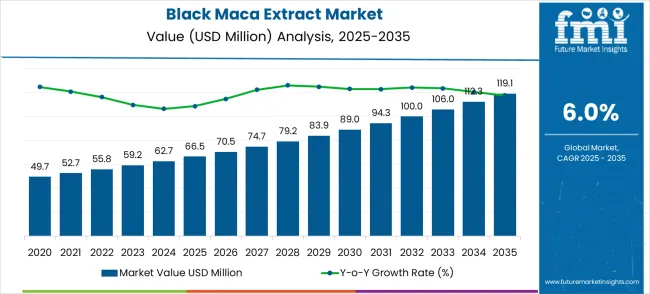
From 2021 to 2025, the market expands at a steady pace, with incremental increases through values of USD 52.7 million in 2022, USD 55.8 million in 2023, USD 59.2 million in 2024, and USD 62.7 million in 2025. The growth during this phase reflects the gradual adoption of black maca extract as a popular functional food and dietary supplement. The compound annual growth rate for this segment is consistent, suggesting the market is in an early stage of growth but does not yet show rapid acceleration or drastic fluctuations.
Between 2025 and 2030, the black maca extract market is projected to expand from USD 66.5 million to USD 89.0 million, resulting in a value increase of USD 22.5 million, which represents 42.8% of the total forecast growth for the decade. This phase of growth will be shaped by increasing consumer adoption of natural wellness products, growing demand for adaptogenic supplements in health and fitness applications, and rising awareness of black maca's unique nutritional properties. Supplement manufacturers and nutraceutical companies are expanding their black maca extract product portfolios to address the growing demand for premium natural ingredients and specialized extraction ratios.
From 2030 to 2035, the market is forecast to grow from USD 89.0 million to USD 119.1 million, adding another USD 30.1 million, which constitutes 57.2% of the overall ten-year expansion. This period is expected to be characterized by widespread adoption of standardized extraction processes, integration of advanced purification technologies, and development of specialized formulations for targeted health applications. The growing demand for premium natural ingredients and personalized nutrition solutions will drive adoption of sophisticated black maca extracts with enhanced bioavailability and potency characteristics.
Between 2020 and 2025, the black maca extract market experienced steady expansion, driven by increasing consumer interest in traditional superfoods and growing recognition of adaptogenic ingredients in wellness applications. The market developed as supplement manufacturers and functional food companies recognized the unique properties of black maca compared to other maca varieties. Natural health trends and clean label requirements began emphasizing the importance of high-quality botanical extracts in premium wellness products.
| Metric | Value |
|---|---|
| Estimated Value in (2025E) | USD 66.5 million |
| Forecast Value in (2035F) | USD 119.1 million |
| Forecast CAGR (2025 to 2035) | 6.0% |
Between 2026 and 2030, the market continues to grow, reaching USD 89.0 million by 2030, with intermediate values of USD 70.5 million in 2026, USD 74.7 million in 2027, and USD 79.2 million in 2028. This phase indicates steady progress, underpinned by increasing consumer preference for herbal remedies and plant-based supplements. There is also greater global interest in the health benefits of black maca, particularly in regions where natural, organic products are gaining market share.
From 2031 to 2035, the market sees continued growth, ultimately reaching USD 119.1 million. The final years’ witness values of USD 94.3 million in 2032, USD 100.0 million in 2033, USD 106.0 million in 2034, and USD 112.3 million in 2035. The trendline for the black maca extract market is best represented by a linear trajectory, as the market shows a steady and predictable rise without drastic fluctuations. This consistent growth highlights the market’s stability, which is primarily driven by rising health-conscious consumer preferences and increased availability of black maca extract in various forms across global markets.
Market expansion is being supported by the increasing consumer awareness of natural health solutions and the corresponding demand for premium botanical extracts that provide targeted wellness benefits. Modern consumers are increasingly focused on proactive health management through natural ingredients that support energy, vitality, and overall well-being. Black maca extract provides unique nutritional compounds and bioactive ingredients that distinguish it from other maca varieties while offering specific health benefits for active lifestyles and wellness-oriented consumers.
The growing emphasisfocus on functional foods and nutraceutical products is driving demand for concentrated botanical extracts that can deliver standardized potency and consistent quality in supplement formulations. Consumer preference for clean label products and natural alternatives to synthetic ingredients is creating opportunities for premium black maca extracts with verified purity and extraction standards. The rising adoption of traditional superfoods and adaptogenic ingredients in mainstream wellness markets is also contributing to increased demand for black maca extracts across different product categories and consumer demographics.
The market is segmented by extract ratio, end-use, and region. By extract ratio, the market is divided into ratio 2:1, ratio 4:1, ratio 5:1, ratio 10:1, and ratio 20:1. By end-use, the market is categorized into health products, functional food, medicines, cosmetics, and others. Regionally, the market is divided into North America, Europe, East Asia, South Asia & Pacific, Latin America, and Middle East & Africa.
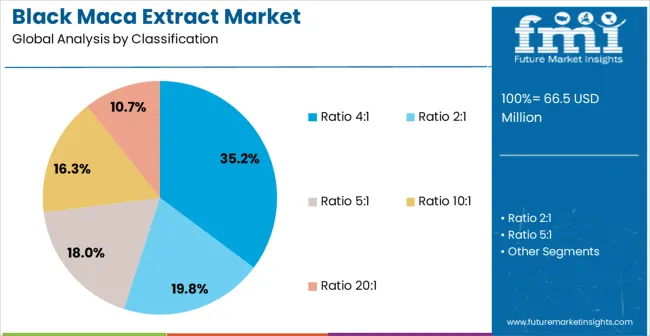
The ratio 4:1 extract segment is projected to account for 35.2% of the black maca extract market in 2025, solidifying its status as the most widely used concentration in the industry. This ratio strikes a balance between potency and cost-effectiveness, making it the preferred choice for manufacturers in supplement and functional food applications. The 4:1 extract offers consistent bioactive content and reliable manufacturing processes, meeting the needs of both producers and consumers. Its proven ability to deliver dependable nutritional benefits makes it ideal for standardized formulations, ensuring it remains the central driver of black maca extract demand. The segment's widespread acceptance across various product formulations underscores its dominance in the market.
The ratio 4:1 extract segment is projected to account for 35.2% of the black maca extract market in 2025, reaffirming its position as the category's most widely adopted concentration level. Manufacturers increasingly understand the optimal balance of potency and cost-effectiveness offered by 4:1 extracts in supplement and functional food applications, including standardized bioactive content, reliable manufacturing processes, and consumer acceptability. Ratio 4:1 extracts' proven performance in delivering consistent nutritional benefits and simplified formulation requirements directly addresses manufacturers' needs for dependable ingredient solutions.
This extract ratio forms the foundation of most commercial product positioning, as it represents the optimal concentration for standard wellness applications while maintaining cost-effectiveness for volume production. Industry validation and extensive consumer acceptance continue to strengthen adoption of 4:1 extraction ratios. With supplement manufacturers demanding reliable ingredient performance and consumers seeking effective natural products, 4:1 extracts align with both formulation efficiency and market accessibility goals. Their widespread compatibility across diverse product formulations ensures sustained market dominance, making them the central concentration driver of black maca extract demand.
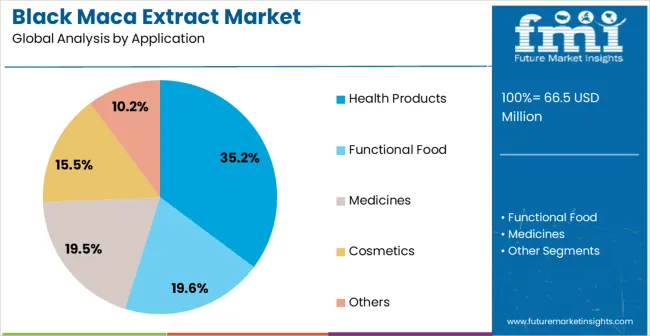
The health products segment is projected to represent 35.2% of black maca extract demand in 2025, reinforcing its role as the dominant application for natural wellness ingredients. Supplement manufacturers focus on health product applications due to their strong consumer appeal, direct wellness benefits, and ability to deliver targeted formulations for energy support, vitality, and overall nutrition. The growing consumer interest in natural and preventive health solutions has led to increased demand for these products. As the demand for personalized nutrition grows and consumers seek premium, effective wellness solutions, health products will continue to lead the market for black maca extract, reinforcing their importance in the wellness and supplement industries.
The health products application is projected to represent 35.2% of black maca extract demand in 2025, underscoring its role as the primary application category for natural wellness ingredients. Supplement manufacturers consistently focus on health product applications for their direct wellness positioning, consumer market accessibility, and ability to showcase ingredient benefits through targeted formulations. Positioned as essential wellness supplements, health products offer both consumer benefits, such as energy support and nutritional enhancement, and market advantages, including premium pricing opportunities and brand differentiation potential.
The segment is supported by increasing consumer investment in preventive health solutions and growing demand for natural energy and vitality supplements. Additionally, manufacturers are increasingly developing specialized health product formulations with synergistic ingredients, enhancing product efficacy and justifying premium pricing for comprehensive wellness solutions. As natural health consciousness continues expanding globally and personalized nutrition approaches gain acceptance, health products applications will continue to dominate extract demand, reinforcing their essential positioning within the premium supplement market.
The black maca extract market is advancing steadily due to increasing consumer interest in traditional superfoods and growing demand for natural ingredients that support energy, vitality, and overall wellness in modern lifestyles. The market faces challenges including supply chain concerns, quality standardization requirements, and competition from other adaptogenic ingredients. Innovation in extraction technologies and responsible sourcing practices continue to influence product quality and market expansion patterns.
The black maca extract market is advancing steadily due to increasing consumer interest in traditional superfoods and growing demand for natural ingredients that support energy, vitality, and overall wellness in modern lifestyles. However, the market faces challenges including supply chain sustainability concerns, quality standardization requirements, and competition from other adaptogenic ingredients. Innovation in extraction technologies and sustainable sourcing practices continue to influence product quality and market expansion patterns.
The growing adoption of advanced extraction technologies is enabling superior product quality and consistency in black maca extract production through standardized processing parameters, enhanced bioactive preservation, and improved yield efficiency. Supercritical CO2 extraction and advanced water-alcohol extraction systems equipped with temperature and pressure control provide exceptional extract purity while maintaining the integrity of heat-sensitive compounds. These technologies offer superior standardization and batch consistency, particularly beneficial for pharmaceutical-grade applications and premium supplement formulations requiring verified potency and quality specifications.
Modern black maca extract manufacturers are incorporating comprehensive sourcing programs and supply chain traceability systems to ensure ethical sourcing practices and environmental responsibility. Advanced agricultural partnerships and direct farmer relationships enable transparent sourcing documentation, quality control at origin, and cultivation practices that support long-term ingredient availability. These programs enhance product authenticity while providing the supply chain transparency necessary for premium brand positioning and consumer confidence in natural product integrity.
The growing adoption of advanced extraction technologies is enabling superior product quality and consistency in black maca extract production through standardized processing parameters, enhanced bioactive preservation, and improved yield efficiency. Supercritical CO2 extraction and advanced water-alcohol extraction systems equipped with temperature and pressure control provide exceptional extract purity while maintaining the integrity of heat-sensitive compounds. These technologies offer superior standardization and batch consistency, particularly beneficial for pharmaceutical-grade applications and premium supplement formulations requiring verified potency and quality specifications.
Modern black maca extract manufacturers are incorporating comprehensive sustainability programs and supply chain traceability systems to ensure ethical sourcing practices and environmental responsibility. Advanced agricultural partnerships and direct farmer relationships enable transparent sourcing documentation, quality control at origin, and sustainable cultivation practices that support long-term ingredient availability. These programs enhance product authenticity while providing the supply chain transparency necessary for premium brand positioning and consumer confidence in natural product integrity.
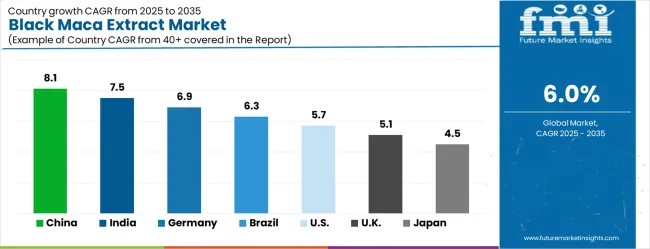
| Country | CAGR (2025-2035) |
|---|---|
| China | 8.1% |
| India | 7.5% |
| Germany | 6.9% |
| Brazil | 6.3% |
| United States | 5.7% |
| United Kingdom | 5.1% |
| Japan | 4.5% |
The black maca extract market is experiencing steady growth globally, with China leading at 8.1% CAGR through 2035, driven by rapidly growing health supplement market, increasing consumer wellness awareness, and expanding nutraceutical industry capabilities. India follows at 7.5%, supported by growing middle-class health consciousness, traditional medicine integration, and increasing dietary supplement adoption. Germany shows robust growth at 6.9%, emphasizingunderscoring natural health product excellence and premium botanical supplement development. Brazil records 6.3%, focusing on natural ingredients market expansion and functional food innovation. The United States demonstrates 5.7% growth, prioritizing wellness product innovation and premium supplement market development. The United Kingdom shows 5.1% expansion, supported by wellness trends and natural health product adoption. Japan maintains 4.5% growth, leveraging quality manufacturing expertise and health-conscious consumer markets.
The report covers an in-depth analysis of 40+ countries ; seven topwith top-performing countries are highlighted below.
The black maca extract market in China is expected to grow at a CAGR of 8.1% from 2025 to 2035. The country’s growing interest in herbal and traditional supplements is a major driver for the demand for Black Maca. As health consciousness rises among Chinese consumers, there is increasing preference for natural products that offer energy and stamina benefits. Black Maca, known for its potential to enhance vitality and overall well-being, is gaining traction in China, particularly among the working population and athletes. The growing trend of plant-based nutrition is further boosting demand. With a strong manufacturing base, China also plays a pivotal role in the global supply of Black Maca extract, helping fuel the local market.
Revenue from black maca extract in China is projected to exhibit the highest growth rate with a CAGR of 8.1% through 2035, driven by massive expansion of the health supplement market and comprehensive consumer education programs promoting natural wellness solutions. The country's growing middle-class population and increasing health consciousness create substantial demand for premium botanical extracts capable of supporting active lifestyles and preventive health approaches. Major nutraceutical companies and health product manufacturers are establishing comprehensive ingredient sourcing capabilities to serve both domestic wellness market demand and international export opportunities. Consumer wellness trends and traditional medicine integration programs are supporting adoption of adaptogenic ingredients and natural health solutions throughout urban and suburban markets.
The black maca extract market in India is set for significant growth at a CAGR of 7.5% from 2025 to 2035. The Indian market is experiencing increased awareness of the health benefits associated with herbal supplements, particularly among urban consumers. With rising disposable income and the growing fitness culture, Black Maca is becoming a popular choice for those seeking to improve energy levels and vitality. The market is further boosted by the growth in the organic food and wellness sectors, with consumers increasingly looking for natural solutions to improve their well-being. The popularity of traditional medicine is promoting the use of herbal extracts like Black Maca in India.
Revenue from black maca extract in India is projected to expand at a CAGR of 7.5%, supported by growing integration of traditional medicine systems with modern wellness approaches and increasing consumer adoption of natural health supplements. The country's expanding middle class and rising health awareness are creating significant opportunities for premium botanical extract manufacturers serving diverse wellness and functional food applications. Traditional medicine practitioners and modern healthcare professionals are implementing natural ingredient recommendations and lifestyle medicine approaches to support comprehensive wellness programs. Government initiatives supporting natural health product development and Ayurvedic medicine modernization are facilitating ingredient adoption and quality standardization programs that enhance market development.
The United States is expected to see a growth rate of CAGR 5.7% in the Black Maca extract market from 2025 to 2035. As the demand for plant-based and natural supplements continues to rise, Black Maca is becoming a popular choice for those seeking natural energy boosters. The USA market for herbal supplements is expanding, with more consumers opting for natural products to enhance their health and well-being. Black Maca is particularly gaining attention in the sports nutrition sector, where it is touted for its stamina and endurance benefits. The increasing awareness around holistic health practices and the availability of Black Maca in various forms, such as capsules and powders, is expected to drive market growth.
Demand for black maca extract in the USA is projected to grow at a CAGR of 5.7%, supported by leading wellness brands, comprehensive product innovation programs, and strong consumer preference for premium natural supplements with verified quality and potency. American supplement manufacturers are increasingly focused on ingredient differentiation, clean label formulations, and comprehensive quality assurance programs that ensure optimal product safety and efficacy. The market is characterized by strong investment in ingredient research, comprehensive testing protocols, and strategic partnerships between supplement companies and botanical extract suppliers. Consumer education programs and wellness lifestyle trends are supporting adoption of adaptogenic ingredients while fostering innovation in natural health product formulations.
The black maca extract market in Germany is forecast to expand at a CAGR of 6.9% from 2025 to 2035. The German market is driven by increasing consumer interest in natural and organic supplements as people seek alternatives to synthetic products. Black Maca, known for its health benefits such as boosting endurance and reducing stress, is gaining traction in the sports and fitness sector. Moreover, Germany’s strong inclination towards holistic health practices is contributing to the increasing demand for herbal extracts. The shift toward natural remedies and plant-based diets in Germany is expected to continue driving growth in the Black Maca market.
Revenue from black maca extract in Germany is projected to grow at a CAGR of 6.9%, driven by the country's leadership in natural health products and comprehensive botanical supplement development programs. German supplement manufacturers consistently invest in premium ingredient technologies that deliver superior quality characteristics while meeting stringent European natural product regulations and consumer expectations. Research institutions and natural product companies are collaborating on botanical extract research programs that integrate traditional knowledge with modern extraction science and quality validation. Export market development programs are enabling German supplement companies to serve global natural health markets while maintaining their reputation for quality excellence and manufacturing precision.
Demand for black maca extract in Brazil is expected to witness a CAGR of 6.3% from 2025 to 2035. Brazil has a well-established culture of using natural herbs for health benefits, and Black Maca fits well within this tradition. The country’s growing focus on fitness and active lifestyles is contributing to increased demand for energy-boosting supplements. Brazil’s expanding e-commerce platforms have made natural supplements more accessible, further driving growth in the Black Maca market. The increasing popularity of herbal medicine and natural wellness products is expected to continue fueling demand in the coming decade.
Revenue from black maca extract in Brazil is projected to grow at a CAGR of 6.3%, supported by expanding natural ingredients market development programs and growing innovation in functional food applications and wellness product categories. Brazilian food and supplement companies are implementing comprehensive natural ingredient strategies that include botanical extract procurement and product development capabilities. Technology partnership programs and international collaboration initiatives are facilitating access to advanced extraction technologies while supporting local ingredient processing and quality development. Functional food innovation programs and wellness product development projects are creating opportunities for deployment of premium botanical extracts in diverse consumer applications.
The black maca extract market in the United Kingdom is projected to grow at a CAGR of 5.1% from 2025 to 2035. The UK’s increasing interest in plant-based and natural wellness products is contributing to the demand for Black Maca, particularly in the growing fitness and wellness segments. As consumers continue to seek more natural and organic health products, Black Maca is gaining popularity due to its reputed benefits in boosting energy, improving stamina, and supporting mental health. The market is also driven by the growing awareness of alternative supplements in the UK, as well as the increasing availability of Black Maca through retail and online stores.
Revenue from black maca extract in the UK is projected to grow at a CAGR of 5.1% through 2035, supported by strong wellness trends and comprehensive natural health product adoption programs among health-conscious consumers. British supplement companies and wellness brands are developing innovative botanical extract products while establishing quality verification protocols and consumer education programs for premium natural ingredients. Consumer wellness trends and lifestyle medicine approaches are supporting natural supplement adoption while fostering innovation in botanical extract applications and delivery systems. Technology development programs and ingredient innovation initiatives are encouraging research and development in natural health product formulations and quality optimization.
Revenue from black maca extract in Japan is projected to expand at a CAGR of 4.5%, driven by the country's expertise in quality manufacturing and advanced health-conscious consumer market development capabilities. Japanese manufacturers are developing sophisticated botanical extract products while maintaining extremely high quality and purity standards required for domestic and international natural health product applications. Technology integration programs and manufacturing optimization initiatives are enabling efficient production of premium botanical extracts while maintaining cost-effectiveness and quality consistency. Research and development partnerships between supplement companies and ingredient technology specialists are advancing extraction science development and product optimization for Japanese consumer preferences and international export applications.
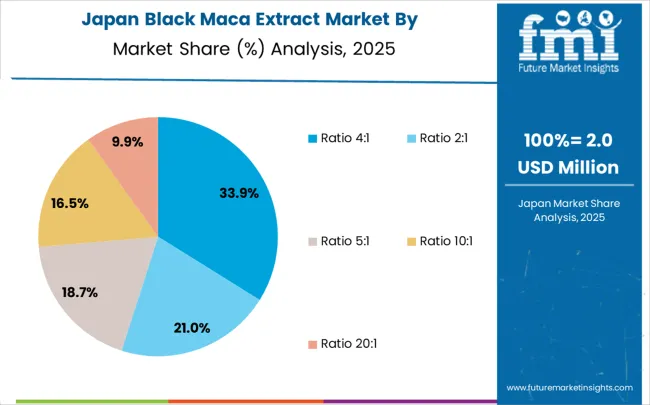
Black maca extract market in Japan is projected to grow at a CAGR of 4.5% from 2025 to 2035. The country’s rising interest in holistic health practices and natural wellness solutions is driving demand for Black Maca. Known for its energy-boosting and mental clarity benefits, Black Maca is gaining traction among Japanese consumers, especially in corporate wellness programs and among professionals seeking enhanced productivity. Japan’s growing preference for plant-based dietary supplements is further supporting the market. The country’s strong consumer base for herbal products, coupled with an increasing awareness of natural alternatives to traditional pharmaceuticals, makes Black Maca a popular choice. As Japan continues to focus on wellness and preventative health, Black Maca is expected to maintain its appeal, particularly in urban areas where health-consciousness is high.
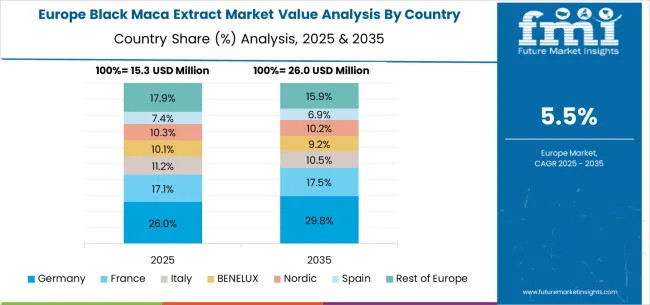
The black maca extract market in Europe is projected to grow from USD 15.3 million in 2025 to USD 26.0 million by 2035, registering a CAGR of 5.5% over the forecast period. Germany will strengthen its leadership, rising from 26.0% in 2025 to 29.8% by 2035, supported by its strong natural health products industry and growing consumer adoption of botanical supplements. France is expected to account for 17.1% in 2025, edging up to 17.5% by 2035, underpinned by established wellness traditions and demand for functional nutrition. Italy will hold 11.2% in 2025, decreasing to 10.5% by 2035, reflecting steady but maturing demand in nutraceuticals.
The BENELUX region will capture 10.1% in 2025, softening slightly to 9.2% by 2035, reflecting consolidation of specialty natural product suppliers. The Nordic countries are projected to hold 7.4% in 2025, growing to 9.2% by 2035, supported by early adoption of plant-based supplements and strong consumer wellness trends. Spain will represent 10.3% in 2025, remaining steady at 10.2% by 2035, reflecting moderate but consistent growth in herbal and wellness-focused products. Meanwhile, the Rest of Europe will decline from 17.9% in 2025 to 15.9% by 2035, reflecting slower uptake in Eastern Europe relative to Western European health markets.
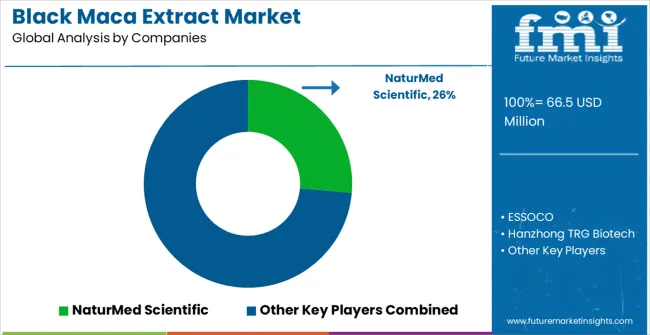
The black maca extract market is characterized by competition among specialized botanical extract manufacturers, nutraceutical ingredient suppliers, and natural health product companies focusing on high-quality extraction processes and standardized ingredient solutions. Companies are investing in advanced extraction technologies, comprehensive quality control programs, sourcing initiatives, and technical support services to deliver reliable, potent, and cost-effective black maca extracts for diverse wellness applications. Technology innovation, quality assurance, and supply chain management are central to strengthening product portfolios and market positioning in this specialized botanical ingredients sector.
NaturMed Scientific provides comprehensive botanical extract solutions with a focus on standardized extraction processes, quality assurance programs, and technical support for supplement and functional food applications. ESSOCO delivers specialized natural ingredient solutions with an focus on sourcing, advanced extraction technologies, and comprehensive quality documentation for premium wellness products. Hanzhong TRG Biotech offers advanced botanical processing capabilities with a focus on extraction ratio optimization and quality standardization for nutraceutical applications.
Xi'an Tianguangyuan Biotechnology provides specialized maca extract manufacturing with an focus on concentration ratios, purity standards, and comprehensive testing protocols. Changsha Staherb Natural Ingredients delivers extensive botanical extract portfolios with a focus on standardized potency, regulatory compliance, and application-specific formulations for health products, functional foods, and cosmetic applications across diverse market segments while maintaining focus on quality assurance, supply chain transparency, and cost-effective manufacturing for natural health ingredient applications.
The black maca extract market is characterized by competition among specialized botanical extract manufacturers, nutraceutical ingredient suppliers, and natural health product companies focusing on high-quality extraction processes and standardized ingredient solutions. Companies are investing in advanced extraction technologies, comprehensive quality control programs, sustainable sourcing initiatives, and technical support services to deliver reliable, potent, and cost-effective black maca extracts for diverse wellness applications. Technology innovation, quality assurance, and supply chain sustainability are central to strengthening product portfolios and market positioning in this specialized botanical ingredients sector.
NaturMed Scientific provides comprehensive botanical extract solutions with focus on standardized extraction processes, quality assurance programs, and technical support for supplement and functional food applications. ESSOCO delivers specialized natural ingredient solutions with emphasis on sustainable sourcing, advanced extraction technologies, and comprehensive quality documentation for premium wellness products. Hanzhong TRG Biotech offers advanced botanical processing capabilities with focus on extraction ratio optimization and quality standardization for nutraceutical applications.
Xi'an Tianguangyuan Biotechnology provides specialized maca extract manufacturing with emphasis on concentration ratios, purity standards, and comprehensive testing protocols. Changsha Staherb Natural Ingredients delivers extensive botanical extract portfolios with focus on standardized potency, regulatory compliance, and application-specific formulations for health products, functional foods, and cosmetic applications across diverse market segments while maintaining focus on quality assurance, supply chain transparency, and cost-effective manufacturing for natural health ingredient applications.
Black maca extract represents a premium botanical ingredient derived from Lepidium meyenii, a cruciferous root vegetable cultivated in Peru's high-altitude Andes mountains, with the global market valued at $66.5 million in 2023 and projected to reach $119.1 million by 2030, growing at a 6.0% CAGR. This specialized extract, concentrated at ratios ranging from 2:1 to 20:1, contains bioactive compounds including macamides, macaenes, and glucosinolates that support male reproductive health, energy metabolism, and adaptogenic functions. Market growth is driven by increasing consumer interest in natural wellness solutions, expanding functional food applications, and growing awareness of traditional Andean superfoods. However, scaling requires coordinated efforts across sustainable cultivation practices, standardized extraction processes, clinical validation, and supply chain traceability.
Agricultural Development Programs: Establish maca cultivation support programs in suitable high-altitude regions, providing technical assistance for soil preparation, seed selection, and organic farming practices. Offer subsidized access to specialized equipment for root harvesting and post-harvest handling optimized for extract production.
Research and Development Funding: Finance clinical studies validating black maca's health benefits and establishing safe consumption guidelines for different extract concentrations. Support research institutions investigating bioactive compound mechanisms, optimal extraction parameters, and standardized potency testing methods.
Quality Standards Framework: Develop national standards for black maca extract quality including heavy metal limits, pesticide residue thresholds, and bioactive compound specifications. Create certification programs ensuring extract authenticity and preventing adulteration with lower-grade maca varieties.
Export Promotion Initiatives: Provide trade facilitation support for black maca extract exporters including regulatory compliance assistance, international market access programs, and participation in global nutraceutical trade shows. Establish quality certification systems recognized by major importing countries.
Indigenous Rights Protection: Implement benefit-sharing agreements ensuring indigenous Andean communities receive fair compensation for traditional knowledge and genetic resources. Support community-based cultivation programs maintaining traditional farming practices while meeting commercial quality requirements.
Extract Quality Standards: Develop comprehensive analytical methods for quantifying key bioactive compounds including macamides, macaenes, and total phenolic content across different extract ratios. Establish standardized testing protocols for moisture content, microbial safety, and heavy metal contamination.
Authentication and Traceability Systems: Create DNA fingerprinting protocols distinguishing black maca from yellow and red varieties, preventing substitution and ensuring variety authenticity. Develop blockchain-based traceability systems documenting cultivation origin, processing methods, and supply chain custody.
Clinical Evidence Development: Coordinate systematic reviews and meta-analyses of black maca research, identifying gaps in clinical evidence and prioritizing future research directions. Establish clinical trial registries tracking ongoing maca research and facilitating data sharing between research groups.
Responsible Sourcing Guidelines: Develop frameworks addressing environmental impact, fair trade practices, and biodiversity conservation in maca cultivation regions. Create certification standards ensuring ethical harvesting practices and soil conservation measures.
Sustainable Sourcing Guidelines: Develop sustainability frameworks addressing environmental impact, fair trade practices, and biodiversity conservation in maca cultivation regions. Create certification standards ensuring responsible harvesting practices and soil conservation measures.
Market Education Programs: Launch consumer education initiatives explaining differences between black, yellow, and red maca varieties, optimal extract ratios for different applications, and evidence-based health benefits. Develop healthcare professional training programs on maca supplementation and potential interactions.
Advanced Extraction Technologies: Invest in supercritical CO2 extraction systems preserving heat-sensitive bioactive compounds while achieving high concentration ratios. Develop enzyme-assisted extraction processes improving yield efficiency and maintaining bioactivity of macamides and macaenes.
Quality Control Systems: Implement comprehensive testing protocols including HPLC analysis for bioactive compounds, microbiological testing for pathogens, and heavy metal screening using ICP-MS technology. Develop fingerprint analysis capabilities ensuring batch-to-batch consistency and detecting adulteration.
Product Diversification: Create specialized extract formulations targeting specific applications including standardized ratios for sports nutrition, reproductive health supplements, and functional food ingredients. Develop water-soluble extract forms enabling beverage applications and improved bioavailability.
Supply Chain Integration: Establish direct relationships with certified organic maca growers ensuring consistent raw material quality and greensustainable sourcing practices. Develop vertical integration strategies controlling cultivation, processing, and distribution to maintain quality standards.
Innovation in Delivery Systems: Develop encapsulation technologies protecting extract stability during storage and improving bioavailability. Create customized extract blends combining black maca with complementary adaptogenic herbs for synergistic effects.
Product Development Strategies: Formulate targeted products addressing specific consumer segments including male health supplements, energy enhancement products, and stress management formulations. Develop functional foods incorporating black maca extract in protein powders, energy bars, and beverage applications.
Clinical Validation Programs: Conduct proprietary clinical studies demonstrating efficacy of specific black maca extract formulations and optimal dosing protocols. Develop biomarker panels measuring extract effects on hormonal balance, energy metabolism, and stress response indicators.
Consumer Education Initiatives: Create evidence-based marketing materials explaining black maca's traditional use, scientific research, and optimal consumption recommendations. Develop educational content differentiating black maca from other varieties and explaining extract concentration benefits.
Quality Assurance Protocols: Implement incoming raw material testing ensuring extract potency, purity, and consistency. Develop finished product testing protocols validating label claims and ensuring shelf-life stability of bioactive compounds.
Regulatory Compliance Management: Maintain comprehensive documentation supporting health claims and ensuring compliance with food safety regulations across different markets. Develop adverse event reporting systems and post-market surveillance protocols.
Responsible Agriculture Investment: Finance organic maca cultivation projects in Peru and other suitable high-altitude regions, supporting infrastructure development for eco-friendly farming practices. Structure investments with environmental and social impact metrics tied to community development and biodiversity conservation.
Sustainable Agriculture Investment: Finance organic maca cultivation projects in Peru and other suitable high-altitude regions, supporting infrastructure development for sustainable farming practices. Structure investments with environmental and social impact metrics tied to community development and biodiversity conservation.
Processing Technology Development: Back companies developing innovative extraction technologies improving yield efficiency, preserving bioactivity, and reducing environmental impact. Support joint ventures between extraction technology providers and maca processing companies.
Market Access and Distribution: Fund distribution networks connecting small-scale Peruvian producers with global markets while ensuring fair pricing and quality standards. Support development of direct-trade relationships eliminating intermediaries and improving farmer margins.
Clinical Research Funding: Finance randomized controlled trials investigating black maca's health benefits, optimal dosing protocols, and safety profiles. Support post-market surveillance studies tracking long-term safety and efficacy in real-world applications.
Brand Development and Marketing: Invest in consumer brand development emphasizing authenticity, sustainability, and authenticity and scientific validation. Support companies developing premium black maca products targeting health-conscious consumers willing to pay premiums for quality and traceability.
| Items | Values |
|---|---|
| Quantitative Units (2025) | USD 66.5 million |
| Extract Ratio | Ratio 2:1, Ratio 4:1, Ratio 5:1, Ratio 10:1, Ratio 20:1 |
| End-Use | Health Products, Functional Food, Medicines, Cosmetics, Others |
| Regions Covered | North America, Europe, East Asia, South Asia & Pacific, Latin America, Middle East & Africa |
| Countries Covered | United States, Canada, United Kingdom, Germany, France, China, Japan, South Korea, India, Brazil, Australia and 40+ countries |
| Key Companies Profiled | NaturMed Scientific, ESSOCO, Hanzhong TRG Biotech, Xi'an Tianguangyuan Biotechnology, Changsha Staherb Natural Ingredients |
| Additional Attributes | Dollar sales by extract ratio and application type, regional consumption trends across health supplement markets, competitive landscape analysis with established botanical extract manufacturers and emerging natural ingredient providers, customer preferences for different concentration ratios versus extraction methods, integration with functional food formulations and cosmetic applications |
The global black maca extract market is estimated to be valued at USD 66.5 million in 2025.
The market size for the black maca extract market is projected to reach USD 119.1 million by 2035.
The black maca extract market is expected to grow at a 6.0% CAGR between 2025 and 2035.
The key product types in black maca extract market are ratio 4:1, ratio 2:1, ratio 5:1, ratio 10:1 and ratio 20:1.
In terms of application, health products segment to command 35.2% share in the black maca extract market in 2025.






Our Research Products

The "Full Research Suite" delivers actionable market intel, deep dives on markets or technologies, so clients act faster, cut risk, and unlock growth.

The Leaderboard benchmarks and ranks top vendors, classifying them as Established Leaders, Leading Challengers, or Disruptors & Challengers.

Locates where complements amplify value and substitutes erode it, forecasting net impact by horizon

We deliver granular, decision-grade intel: market sizing, 5-year forecasts, pricing, adoption, usage, revenue, and operational KPIs—plus competitor tracking, regulation, and value chains—across 60 countries broadly.

Spot the shifts before they hit your P&L. We track inflection points, adoption curves, pricing moves, and ecosystem plays to show where demand is heading, why it is changing, and what to do next across high-growth markets and disruptive tech

Real-time reads of user behavior. We track shifting priorities, perceptions of today’s and next-gen services, and provider experience, then pace how fast tech moves from trial to adoption, blending buyer, consumer, and channel inputs with social signals (#WhySwitch, #UX).

Partner with our analyst team to build a custom report designed around your business priorities. From analysing market trends to assessing competitors or crafting bespoke datasets, we tailor insights to your needs.
Supplier Intelligence
Discovery & Profiling
Capacity & Footprint
Performance & Risk
Compliance & Governance
Commercial Readiness
Who Supplies Whom
Scorecards & Shortlists
Playbooks & Docs
Category Intelligence
Definition & Scope
Demand & Use Cases
Cost Drivers
Market Structure
Supply Chain Map
Trade & Policy
Operating Norms
Deliverables
Buyer Intelligence
Account Basics
Spend & Scope
Procurement Model
Vendor Requirements
Terms & Policies
Entry Strategy
Pain Points & Triggers
Outputs
Pricing Analysis
Benchmarks
Trends
Should-Cost
Indexation
Landed Cost
Commercial Terms
Deliverables
Brand Analysis
Positioning & Value Prop
Share & Presence
Customer Evidence
Go-to-Market
Digital & Reputation
Compliance & Trust
KPIs & Gaps
Outputs
Full Research Suite comprises of:
Market outlook & trends analysis
Interviews & case studies
Strategic recommendations
Vendor profiles & capabilities analysis
5-year forecasts
8 regions and 60+ country-level data splits
Market segment data splits
12 months of continuous data updates
DELIVERED AS:
PDF EXCEL ONLINE
Blackout Fabric Laminate Market Size and Share Forecast Outlook 2025 to 2035
Blackcurrant Seed Oil Market Size and Share Forecast Outlook 2025 to 2035
Blackcurrant Powder Market Size and Share Forecast Outlook 2025 to 2035
Black Treacle Market Size and Share Forecast Outlook 2025 to 2035
Black Friday Packaging Market Size and Share Forecast Outlook 2025 to 2035
Black Pepper Market Analysis - Size, Share & Forecast 2025 to 2035
Black & Wood Pellets Industry Analysis in Europe Analysis - Size, Share, & Forecast Outlook 2025 to 2035
Blackstrap Molasses Market Historical Analysis and Forecasts 2025 to 2035
Blackout Fabric Market Analysis – Trends, Growth & Forecast 2025 to 2035
Market Share Insights for Black Friday Packaging Providers
Examining Market Share Trends in the Black Pepper Industry
Market Share Distribution Among Black Seed Oil Suppliers
Black Start Generator Market
Black Friday Sale Market Analysis – Growth & Trends 2024-2034
Blackcurrant Concentrate Market
Black Tea Extracts Market Analysis - Size, Share, and Forecast Outlook 2025 to 2035
Carbon Black Content Tester Market Size and Share Forecast Outlook 2025 to 2035
Carbon Black Market Size, Growth, and Forecast 2025 to 2035
Carbon Black for Packaging Market Growth & Trends 2025 to 2035
Smoked Black Pepper Market Trends - Flavor Innovation & Demand 2025 to 2035

Thank you!
You will receive an email from our Business Development Manager. Please be sure to check your SPAM/JUNK folder too.
Chat With
MaRIA